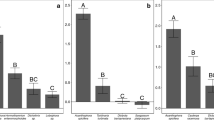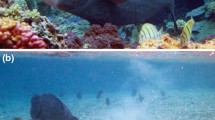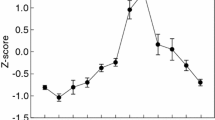Summary
Many coral-reef seaweeds and sessile invertebrates produce both secondary chemicals and mineral or fibrous skeletal materials that can reduce their susceptibility to consumers. Although skeletal materials often have been assumed to function as physical defenses, their deterrent effectiveness may derive from their reduction of prey nutritional quality as well as from noxiousness of the skeletal material itself. To test the relative importance of prey nutritional quality and chemical defenses in susceptibility to predation, we offered reef fishes on Guam a choice of artificial foods varying in nutritional quality (4% versus 22% protein) and in secondary chemistry (spanning approximately natural concentration ranges). Field feeding assays were performed with pachydictyol A from the pantropical brown seaweed genus Dictyota, manoalide from the Micronesian sponge Luffariella variabilis, and a brominated diphenyl ether from the Micronesian sponge Dysidea sp. The results indicated that chemical defenses were less effective in high- than in low-quality foods. In paired assays with metabolite-free controls, all three compounds at natural concentrations significantly reduced feeding by reef fishes only in assays using low-quality food, and not in assays with high-quality food. When fishes were offered an array of artificial foods varying in both food quality and metabolite concentration, food quality significantly affected fish feeding in all three cases, while secondary chemistry was significant in only one. Thus differences in nutritional quality, within the natural range among reef organisms, can be comparable to or greater in importance than secondary chemistry in affecting feeding preferences of their consumers. Reduced nutritional quality may be an important selective advantage of producing indigestible structural materials, in addition to their roles as physical support and defense, in coral reef organisms.
Similar content being viewed by others
References
Belovsky GE (1984) Herbivore optimal foraging: a comparative test of three models. Am Nat 124: 97–115
Coley PD (1983) Herbivory and defensive characteristics of tree species in a lowland tropical forest. Ecol Monogr 53: 209–233
Duffy JE, Hay ME (1990) Seaweed adaptations to herbivory. Bio Science 40: 368–375
Feeny P (1970) Seasonal changes in oak leaf tannins and nutrients as a cause of spring feeding by winter moth caterpillars. Ecology 51: 565–581
Giese AC (1966) Lipids in the economy of marine invertebrates. Physiol Rev 46: 244–298
Harvell CD (1984) Predator-induced defense in a marine bryozoan. Science 224: 1357–1359
Harvell CD, Fenical W, Greene CH (1988) Chemical and structural defenses of Caribbean gorgonians (Pseudopterogorgia spp.). I. Development of an in situ feeding assay. Mar Ecol Prog Ser 49: 287–294
Harvell CD, Fenical W (1989) Chemical and structural defenses of Caribbean gorgonians (Pseudopterogorgia spp.): intracolony localization of defense. Limnol Oceanog 34: 382–389
Hay ME (1984) Predictable spatial escapes from herbivory: how do these affect the evolution of defense mechanisms in seaweeds? Oecologia 64: 396–407
Hay ME, Duffy JE, Pfister CA, Fenical W (1987a) Chemical defense against different marine herbivores: are amphipods insect equivalents? Ecology 68: 1567–1580
Hay ME, Fenical W, Gustafson K (1987b) Chemical defense against diverse coral-reef herbivores. Ecology 68: 1581–1591
Hay ME, Fenical W (1988) Marine plant-herbivore interactions: the ecology of chemical defense. Ann Rev Ecol Syst 19: 111–145
Hay ME, Duffy JE, Fenical W (1988a) Seaweed chemical defenses: among-compound and among-herbivore variance. Proceedings of the 6th International Coral Reef Symposium, Townsville, Australia 3: 43–48
Hay ME, Paul VJ, Lewis SM, Gustafson K, Tucker J, Trindell RN (1988b) Can tropical seaweeds reduce herbivory by growing at night?: diel patterns of growth, nitrogen content, herbivory, and chemical versus morphological defenses. Oecologia 75: 233–245
Hay ME, Renaud PE, Fenical W (1988c) Large mobile versus small sedentary herbivores and their resistance to seaweed chemical defense. Oecologia 75: 246–252
Horn MH (1989) Biology of marine herbivorous fishes. Oceanog Mar Biol Ann Rev 27: 167–272
Littler MM, Taylor PR, Littler DS (1983) Algal resistance to herbivory on a Caribbean barrier reef. Coral Reefs 2: 111–118
McClintock JB (1987) Investigation of the relationship between invertebrate predation and biochemical composition, energy content, spicule armament and toxicity of benthic sponges at McMurdo Sound, Antarctica. Mar Biol 94: 479–487
Millikan MR (1982) Qualitative and quantitative nutrient requirements of fishes: a review. Fish Bull 80: 655–686
Montgomery WL, Gerking SD (1980) Marine macroalgae as foods for fishes: an evaluation of potential food quality. Env Biol Fishes 5: 143–153
Neighbors MA, Horn MH (1991) Nutritional quality of macrophytes eaten and not eaten by two temperate-zone herbivorous fishes: a multivariate comparison. Mar Biol 108: 471–476
Neudecker S (1979) Effects of grazing and browsing fishes on the zonation of corals in Guam. Ecology 60: 666–672
Palmer AR (1979) Fish predation and the evolution of gastropod shell sculpture: experimental and geographic evidence. Evolution 33: 697–713
Paul VJ (1992) Ecological roles for marine secondary metabolites. Explorations in chemical ecology series. Comstock, Ithaca, New York
Paul VJ, Hay ME (1986) Seaweed susceptibility to herbivory: chemical and morphological correlates. Mar Ecol Prog Ser 33: 255–264
Pennings SC, Paul VJ (1992) Effect of plant toughness, calcification and chemistry on herbivory by Dolabella auricularia. Ecology (in press)
Peterson CH, Renaud PE (1989) Analysis of feeding preference experiments. Oecologia 80: 82–86
Pyke GH (1984) Optimal foraging theory: a critical review. Ann Rev Ecol Syst 15: 523–575
Rhoades DF (1983) Herbivore population dynamics and plant chemistry. In: Denno RF, McClure MS (eds) Variable plants and herbivores in natural and managed systems, Academic Press, New York, NY, pp 155–220
Rosenthal GA, Janzen DH (1979) Herbivores. Their interaction with secondary plant metabolites, Academic Press, New York, NY
Sammarco PW, LaBarre S, Coll JC (1987) Defensive strategies of soft corals (Coelenterata: Octocorallia) of the Great Barrier Reef. III. The relationship between ichthyotoxicity and morphology. Oecologia 74: 93–101
Schneider WP, Bundy GL, Lincoln FH, Daniels EG, Pike JE (1977) Isolation and chemical conversions of prostaglandins from Plexaura homomalla: preparation of prostaglandin E2, prostaglandin F2, and their 5,6-trans isomers. J Am Chem Soc 99: 122–1232
Sokal RR, Rohlf FJ (1981) Biometry, Freeman, New York, NY
Steneck RS (1983) Escalating herbivory and resulting adaptive trends in calcareous algal crusts. Paleobiology 9: 44–61
Steneck RS, Watling L (1982) Feeding capabilities and limitation of herbivorous molluscs: a functional group approach. Mar Biol 68: 299–319
Wellington GM (1982) Depth zonation of corals in the Gulf of Panama: control and facilitation by resident reef fishes. Ecol Monogr 52: 223–241
Wylie CR, Paul VJ (1989) Chemical defenses in three species of Sinularia (Coelenterata, Alcyonacea): effects against generalist predators and the butterflyfish Chaetodon unimaculatus Bloch. J Exp Mar Biol Ecol 129: 141–160
Author information
Authors and Affiliations
Rights and permissions
About this article
Cite this article
Duffy, J.E., Paul, V.J. Prey nutritional quality and the effectiveness of chemical defenses against tropical reef fishes. Oecologia 90, 333–339 (1992). https://doi.org/10.1007/BF00317689
Received:
Accepted:
Issue Date:
DOI: https://doi.org/10.1007/BF00317689




